After a long, cold winter working two jobs on top of my reckless pursuit of other passions, I came back to my wild food obsession fully the other day over a handful of acorns.
The acorns were from last fall’s visit to Connecticut. Mom and I gathered them on an ill-fated hike before getting lost in the 1,000 acre forest behind my childhood home—a forest I once knew every inch of that is now riddled with confusing new paths from an abandoned housing development.
Mom had in fact collected some acorns for me earlier that fall, but apparently they require refrigeration or immediate drying (Thayer, 2010) lest they begin to rot. So when I visited in October of 2010, we tossed out the first batch and gathered a second in the forest behind the house (before leading ourselves astray and walking in circles, in the rain and growing darkness, for the better part of an hour).
I refrigerated that second batch until my departure for Colorado, then carried it on the plane in a cooler bag and commenced to drying the acorns on a cookie sheet in front of the woodstove here at 11,000 feet in the Rockies. They were supposed to dry to the point that they rattled in their shells. When that didn’t happen, I considered throwing them out. Instead, I forgot about them for about 7 months.
Cracking Acorns with a Meat Tenderizer
Last week, on a beautiful sunny work-free morning, I absent-mindedly cracked a few of the forsaken acorns over coffee with Gregg. Instead of the bugs and blemishes and rot I expected to find, lo and behold—they were dry, hard as a rock, and looking almost yummy enough to eat. And so it happened that I spent the entire morning cracking acorns gleefully with a meat tenderizer for lack of a nut cracker. It was terribly therapeutic.
Samuel Thayer—Acorn Expert
Samuel Thayer’s chapter on acorns occupies 40 pages of Nature’s Garden (2010), his sequel to Forager’s Harvest. His is a thorough summary of what the wild foods literature has to say on the myriad different kinds of acorns, whether or not the fabled “sweet acorn” is a myth, and how to gather, prepare, and consume every kind of acorn you could possibly imagine and in every which way.
Although I owe my initial interest in acorn-eating to Euell Gibbons, I owe nearly everything I know about how to do it to Samuel Thayer.
This blog entry recounts my experience following Thayer’s suggestions (to the best of my ability) on how to collect, dry, crack, peel, grind, sift, leach, and eat acorn flour. You may glean some clues here, but for all the details, clear instructions, crafty language, and strong opinions, buy the book. It’s awesome.
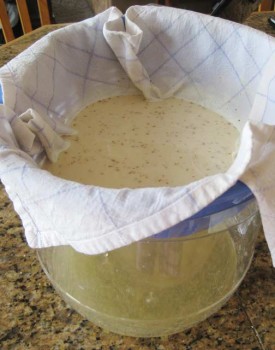
Sweet White Versus Bitter Red—A Fallacy?
In Stalking the Wild Asparagus (1962), Euell Gibbons wrote about sweet acorns that could be eaten without first leaching out the bitter tannins. As a young adult I looked and looked for the “sweet” acorns, but perhaps owing to my shoddy tree-identification skills, I never found one. Thayer says, however, that the whole sweet-versus-not business is best ignored. All acorns have a weird aftertaste due to tannins and other constituents. Therefore, he concludes, we should leach them all before consuming.
Good—because at first I had no idea whether I’d found red or white acorns or some other kind of acorn in between.
Removing Testa from Acorns, Dust from my Laptop
While manually removing the wrinkled testa from the acorn meats (which is Thayer’s next assignment after collecting, drying, and cracking prior to leaching), I was pleased as punch to find that my long-hibernating writing beast was beginning to awaken.
You see, this is why wild food processing is so good! I could have occupied my time worrying about talent lost. Instead, I occupied it removing testa (which Thayer explains can be done by soaking the shelled acorns for 3 minutes and then peeling it away)—time consuming, but a good excuse for meditation or introspection or other zen-related pursuits. It begs the question, however: How many testa must she tediously hand-separate from their meats before Erica finds the desire, motivation, and ability to put fingers to laptop once more?
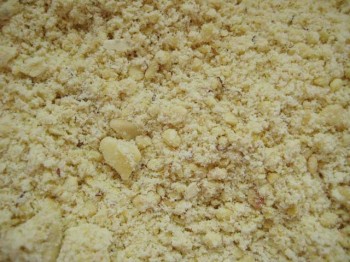
Grinding and Sifting
The next problem was where to grind the acorns. They were so very hard. I decided on the food processor and ran them in batches, each of which went into a sifter to separate out the bigger pieces, which then went back into the food processor. It took forever and the food processor got very hot to the touch. Also, I got many small balls of acorn meats stuck between the screens of my sifter, which should make for some interesting Christmas cookies come December. The reason for all the fuss is that Thayer says uniformly fine flour is “key to cold leaching quickly and thoroughly.”
Leaching
Leaching is how you remove the bitter tannins from the acorns. I opted for cold, fast leaching, and made a makeshift leacher by cutting off the base of a giant plastic Utz pretzel container and fitting it with a spaghetti strainer lined with a thin dish towel. Then I poured in the acorn flour, added water, waited for it to percolate through, then added more water, and so forth—continuing to leach the tannins out into the container below until the wet flour didn’t make my mouth pucker anymore.
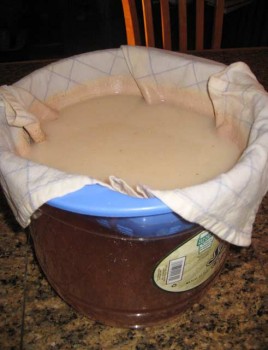
Don’t Use Your Boyfriend’s Dish Towel
What was once a thin white dish towel with a light blue grid pattern, part of a set of four, is now a purply light-chocolate-brown stand-alone that is probably forever relegated to acorn-leaching endeavors.
“I’m sorry, honey. I didn’t realize…”
“It’s okay. It’s not like we entertain with that set anyway.”
Entertain?
Anyway, I leached my acorn flour for two days and then picked up the cloth and squeezed out the liquid (reserving that for Thayer’s suggestion to make “acorn milk” by heating and serving with maple syrup—delicious!) then crumbled the flour into a pan to dry for a two days. I came away with one Mason jar full of flour, the same purple-light-chocolate-brown color which I had inadvertently dyed Gregg’s towel.
Is Acorn Flour Worth the Effort?
Okay so in the end I spent 2-3 hours cracking, detestafying, grinding, and sifting acorns before spending 2-3 days straining, crumbling, and drying the flour. In the process, I lost one dishtowel I didn’t own which can now no longer be part of a set.
Was it worth the effort? Absofreakinlutely.
To date I’ve made Thayer’s “acorn milk” (which I love) as well as pancakes using a simple recipe from The Rural and Native Heritage Cookbook (1985) that calls for equal parts acorn flour and other flour, eggs, sugar, and salt. (Incidentally there are also recipes for “muskrat loaf” and “raccoon delight” in the cookbook, which was originally published by the Lovesick Lake Native Women’s Association as a guide for low income families.)
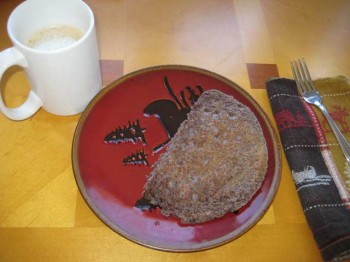
The pancakes came out thin and brown-purple with the most delightful, airy texture. I definitely prefer them to normal pancakes. In fact, they might be the best pancakes I’ve ever eaten. Plus, they taste healthy. So I will guard the remaining supply of acorn flour carefully, perhaps sharing some with deserving individuals out east in a few weeks.
Mom has been tossing the idea of retirement around for a few years now. “I think acorn-gathering and processing will be a perfect retirement activity for you and dad,” I told her. After all, I’m going to need an annual supply of acorns henceforth, and we don’t have oaks up here at 11,000 feet in the Colorado Rockies.
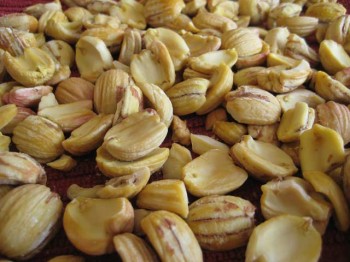

yum!! i always wanted to try to eat acorns, especially white oak which look delicious. thank you!
I was curious if you’re going to give this a try again this fall. This is my first year, so it’s been a lot of trial and error. I’ve found a great way to make shelling go quicker. Putting them in the dehydrator for a few hours has made the shells split. Plus, the testa is sticking to the shell rather than the nut. The shells can be peeled open at the split and the nuts come out nice and clean.
We have a burr oak in the backyard that’s really low on tannin so I’m hoping leaching shouldn’t be too time consuming. Our water is high in iron; I’m wondering if that’ll give the acorns an off taste. Any ideas?
Fantastic description! I love the photos too! I have been eating wild edibles and using wild medicinals for years now and it is always nice to find someone else that has such a passion for it as me. I am definitely putting your site in my favorites to check on regularly.
Luv it